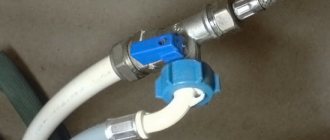Published: 20 Dec 2020
You threw things into the washing machine, turned on the wash and forgot about it for a while, because the automatic equipment does not require attention until the end of the work. But this time, when you went to the washing machine to take out and hang up the clean clothes, you discovered that the washing machine had frozen.
The washing machine can stop at any time, both at the beginning and at the end of the wash; it can stop during rinsing or when it starts spinning. In most cases, equipment owners turn to us for help when the SMA freezes during the spin cycle.
When the washing machine is working properly
Stopping a machine with laundry is unpleasant, but often the reason for the machine getting stuck on the spin cycle is not related to a breakdown. Our inattention or forgetfulness causes us to stop. Here are the main reasons that you can deal with on your own.
No spin program with water stop selected
On programs for delicate fabrics, the machine washes without spinning by default. Depending on the type of program, it may drain the tank or leave things in the water. In the second case, the washing machine hangs on the spin cycle and waits for the drain to be started manually.
HOW TO FIX
Check which program you have chosen. Turn on the drain or spin the items at minimum speed if this does not damage the fabric. Switch the program after the previous wash. Otherwise, the machine will stop again without spinning.
The machine is overloaded with laundry
Loading rates are indicated in the instructions. They differ for different programs and types of fabric. If you put in more items than you need, the machine will wash them, but will not be able to spin them. If the tank is overloaded, protection will be activated to protect parts from unnecessary vibration and damage.
HOW TO FIX
Take some of the things out of the tank and wring them out in two approaches. Next time, load the laundry without exceeding the weight of the laundry for the selected program.
Unbalanced laundry in the drum
The machine does not spin if it fails to distribute the weight of the laundry evenly throughout the drum. As in the case of overload, protection against unnecessary drum shaking is triggered here, and possibly an error message pops up. Therefore, it is not recommended to wash single items such as pillows or small fleecy rugs. They absorb a lot of water and become very heavy, so they begin to hang around the drum when revving up.
Imbalance also appears due to crumpled laundry. For example, small items love to dive into duvet covers. You can wash the lump, but it is difficult to wring out. The machine tries to unravel the lump, but fails and freezes.
HOW TO FIX
Load the machine with items of approximately the same weight so that they are evenly distributed throughout the drum and do not bunch up. You can add a towel to pairs of single pillows or rugs. It is better to wash large bed linens separately from small ones and not mix them with other oversized items.
The washing machine freezes while washing - possible reasons
Most often, the machine stops washing due to problems with the supply, heating or draining of water. We have already discussed such moments in previous articles.
- If the washing machine freezes without filling the tank, see the article Why the washing machine does not fill with water. The main reason is a malfunction of the water supply valve.
- If the machine has washed and stopped with water, refuses to rinse and spin, then see the article Why the washing machine does not drain the water. The main reason is the failure of the drain pump.
- When the washing machine freezes 10–15 minutes after starting and does not heat the water, read the article Why the washing machine does not heat the water. The most common breakdown is a failed heating element. The problem can be easily identified by the cold glass of the sunroof.
Here are other problems that can cause your washing machine to freeze while washing.
The water level sensor has failed - from RUB 1,500*
Without the pressure switch readings, the machine “does not understand” the water level in the tank, so the washing process stops and the machine freezes. In models of washing machines with a screen, a level sensor error may appear on the display.
Failure of the pressure switch is usually associated with three reasons:
- contamination of the compression chamber, for this reason incorrect pressure “comes” to the sensor membrane, and the sensor incorrectly determines the amount of water in the tank;
- problems with the pressure switch tube: it falls off, gets clogged or rubs due to vibrations;
- failure of the sensor itself, the contacts inside of which stick or burn.
HOW TO FIX
The pressure sampling chamber must be cleaned of contaminants. The pressure switch hose should be put back on, cleaned or replaced with a new one. If the sensor itself breaks down, it needs to be replaced.
Engine brushes are worn out - from RUB 1,300*
Brushes are an element of a commutator motor that drives the rotor. Due to constant friction, the embers wear off and contact is lost. First, the machine hangs on the spin cycle, never picking up speed, then it stops spinning the drum during the wash cycle. Worn brushes can also be accompanied by sparking and rattling noise from the motor as the drum rotates. The reason for this is poor contact of worn brushes with the commutator. An engine error code may appear on the display in washing machines with a display.
HOW TO FIX
The old brushes must be removed and new ones installed.
The control unit (electronic controller) is acting up - from RUB 1,800*
Although the control unit has a large margin of reliability, sometimes it fails. Power surges, shaking, humidity or water ingress render smart electronics unusable. The tracks in the motor circuit oxidize or the radio components of the controller burn out. In some cases, the firmware crashes. As a result, the washing machine stops spinning the drum and freezes.
HOW TO FIX
The master tests the control board and, if the firmware fails, reprograms the module. The damaged board will have to be repaired or replaced with a new one. Repairs can be made if the cause is oxidized or burnt tracks, contacts or radio components. If the processor fails, the unit is completely replaced.
The tachometer (Hall sensor) has failed - from RUB 1,800*
It is responsible for controlling the engine rotation speed and connecting the control unit with the motor. If the Hall sensor is faulty, the control module “does not understand” at what speed the drum is rotating, so it stops the program and reports an error.
HOW TO FIX
First of all, you should check the wiring and contacts from the sensor to the motor and from the motor to the control unit. Sometimes the sensor magnet simply unwinds and needs to be tightened. A faulty tachogenerator must be replaced.
* Prices are for labor only; spare parts used for repairs are paid additionally.
Technical problems
Not every person without special education will be able to cope with such a problem as a motor breakdown, heating element burnout, belt breakage, or failure of sensors and pumps. In these cases, it is better to entrust the repair of the machine to professionals who, using special instruments, will conduct the necessary research and competently eliminate the malfunction.
Engine malfunction
A failed engine is one of the breakdowns that will cause the unit to freeze immediately after turning on the program. Modern washing machines are equipped with an inverter motor, which hardly breaks down. But with a commutator motor all sorts of troubles often happen. For example, with frequent use of the device, the electric brushes wear out and are destroyed, which will need to be replaced. The stator winding may break, causing the motor to stop or even burn out. In this case, the entire engine will need to be replaced.
The following factors indicate a motor malfunction:
- when starting, it knocks out the plugs in the shield;
- noise and crackling during operation;
- the engine turns off due to overheating;
- The washing machine does not start.
In extreme cases, when the unit is turned on, smoke and a burning smell may appear, which indicates a problem with the engine. You must immediately disconnect the device from the network, drain the water (if the machine has managed to fill it up) and call a technician.
Belt
All stages of washing take place with a rotating drum. Rotation is impossible without a belt, with which the centrifuge is attached to a pulley connected to the engine of the device. It is especially noticeable that the drum has stopped spinning during the spin cycle. The culprit for this malfunction may be a torn or flying belt. The belt can become unusable both from prolonged use and as a result of drying out during a long period of inactivity of the device.
It is very simple to verify your suspicions - you need to rotate the tank by hand in an empty machine. If there are problems with the belt, it rotates freely, but remains motionless when the device is running. To correct the situation, you need to replace the belt.
Tena
Every washing machine involves heating water, for which a heating element (tubular electric heater) is responsible. This part can fail due to accumulated limescale, frequent power outages, and, finally, simply from old age.
If the heating element fails, the machine may stop working at any stage of the wash, freezing at one time, but most often this happens when switching to rinsing. You can make sure that the water is not heating up by looking at the glass of the door. It will be cold. To leave no doubt as to the reason for the device stopping, you need to test the electrical circuit with a multimeter. The problem is solved by installing a new heating element.
Sensors
All the main processes occurring during the operation of the washing machine are controlled by sensors. If one of them breaks down, the head module does not receive the necessary information, the program crashes, and the machine begins to “strange”: it does not switch modes, does not drain water, does not spin the drum, and so on.
The washing machine has the following sensors.
- Pressostat is a pressure switch, also known as a water level sensor. Controls the amount of water in the tank and prevents overfilling.
- Water temperature sensor - located separately in the tank or built into the heating element.
- Sensor for measuring drum rotation speed.
- Aquasensor - determines the purity of water.
If one of the sensors fails, it needs to be replaced.
Electronic module
The electronic module is the most complex part of the washing machine. It is an electronic board with machine control elements arranged in a special order, the operation of which is directed and synchronized by a microprocessor.
It is important to determine in a timely manner that it is the control module of the machine that is faulty, and not its other parts. Otherwise, you can spend a lot of money replacing the processor, but the failure will remain in place.
The following signs indicate problems with the control module:
- the machine does not respond to user actions;
- does not start the wash and does not allow you to switch programs, the indicators flash randomly;
- does not collect water after starting the wash or drains spontaneously;
- can wash two to three times more than the allotted time;
- The heating element either heats the water too much or leaves it absolutely cold.
If you suspect a faulty control module, it is better to immediately contact a specialist. This is a very serious breakdown, the detection and correction of which requires knowledge and ability to handle special devices. The board can be reflashed or burned transistors and resistors can be replaced. If the microprocessor is damaged, it will have to be replaced.
UBL
The hatch locking device is one of the most important parts that ensures the safe operation of the device. After the housewife has loaded the laundry and turned on the desired mode, the UBL locks the door and signals the control module that work can begin. Without this signal, washing will not take place.
The locking device, like other electrical parts, can become damaged due to frequent power surges or prolonged use. If a malfunction is detected, the UBL must be repaired or replaced with a new part.
Pumps
A common reason for a washing machine getting stuck on one program is a faulty drain pump. Typically, this problem occurs when the device is used for a long time, when the pump motor wears out and burns out. Foreign objects that get into the drain pump from clothing pockets can break the motor blades, causing the entire unit to fail. One way or another, if the pump does not work, it must be replaced.
A washing machine is a complex household appliance, and if it stops switching, freezes during rinsing or spinning, or does not drain water, then there is some kind of malfunction. Some breakdowns can be fixed with your own hands, but most often you have to go to a workshop. Therefore, it is good when the machine has a manufacturer’s warranty.
Why does the washing machine freeze while rinsing - major breakdowns
Some of the faults are the same as during washing: breakdown of the pressure switch, control module, motor brushes and tachometer. We sorted them out earlier. Let's talk separately about the water supply valve. Most often, the SMA does not rinse due to the failure of this node.
Filling valve is faulty - from RUB 1,400*
The valve is responsible for supplying water to the washing machine. Depending on the make and model of the machine, it can have up to three sections. One of them is in charge of filling the rinse water. When the “rinse” part of the valve fails, the automatic machine does not fill the rinse with water and freezes. The display may indicate that there is no water supply.
The electromagnetic coil usually burns out in the valve, so when voltage is applied to it, the membrane does not open and water does not fill.
HOW TO FIX
The valve is not repaired, but replaced with a new one.
* Prices are for labor only, new water supply valve is paid separately.
Possible breakdowns when the washing machine freezes on the spin cycle
Most often, the machine hangs on the spin cycle. As in the case of washing with rinsing, the cause of freezing may be breakdowns of the pressure switch, control unit, tachometer and motor brushes. Here we will look at malfunctions that are specific only to spinning.
Bearings have fallen apart - from RUB 3,000*
When the spin is turned on, the vibrations of the drum and the entire machine increase. If the bearings are in “poor” condition, the drum will play and shake violently during acceleration. If the SMA can still cope with washing and rinsing in this state, although it creaks more than usual, then it can no longer wring out normally due to strong shaking. When trying to accelerate the drum, the washing machine rattles very loudly and the drum does not gain speed.
In addition to the lack of spin, a washing machine with faulty bearings can stain laundry with black grease from the oil seal. And if you remove the back wall of a front-loading machine or the sides of a vertical-loading machine, you can find rusty stains on the tank from the location of the bearings.
HOW TO FIX
The bearings and seal need to be replaced. It is best to do such repairs immediately when the first signs of damage appear. Otherwise, the malfunction may cause the crosspiece to break or damage the tank, and then the entire tank assembly will have to be replaced.
Troubleshooting Indesit machines
Washing machines of this brand may freeze when rinsing or spinning clothes. This may reveal related problems.
They may freeze if the display board is broken. This occurs due to a violation of the thermal insulation of the internal parts of washing units.
Reasons for failure:
- the engine is faulty;
- due to old bearings, play has formed in the drum;
- The heater wire has failed;
- drum defect;
- The heating element is broken;
- The tachogenerator or pressure switch does not work;
- the filter is clogged;
- the contact angle between the rotor commutator and the brushes is broken;
- control module is faulty;
- incorrect load - either too much laundry or too little.
The cause of freezing can also be insufficient amount of laundry in the drum. You should follow the instructions and load the amount of laundry prescribed for a specific model.
We recommend reading: Malfunctions of the Indesit washing machine.
This video explains why the Indesit washing machine freezes; an example is shown on a front-loading model.









